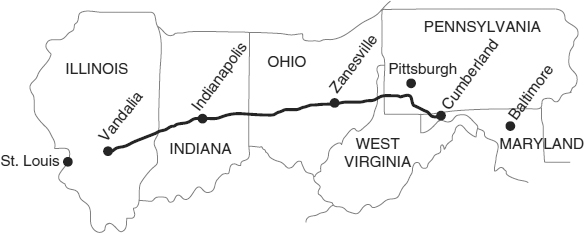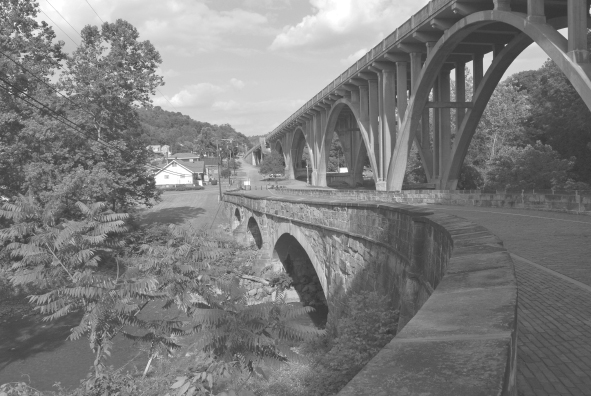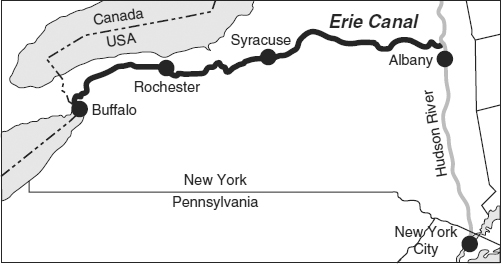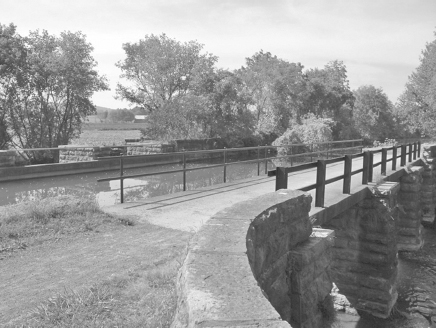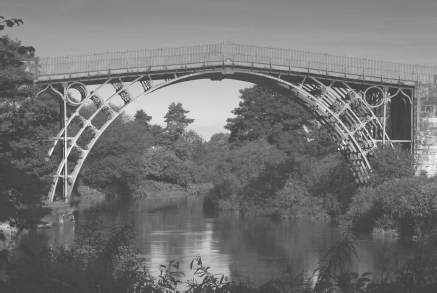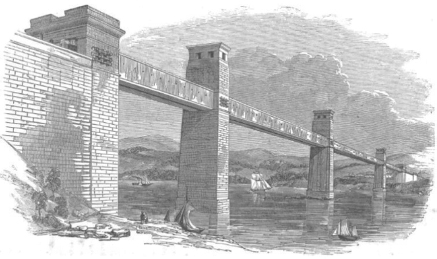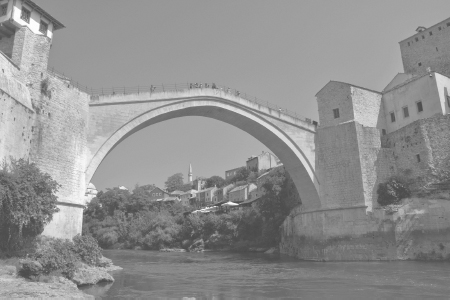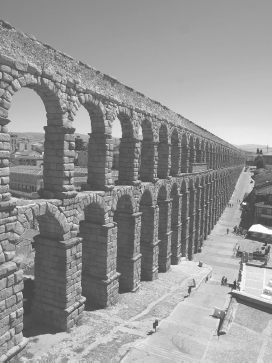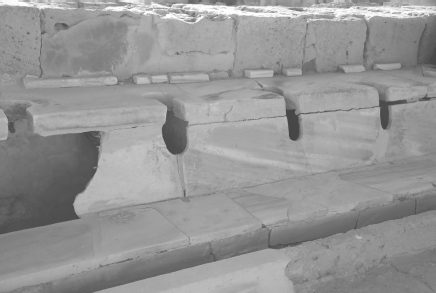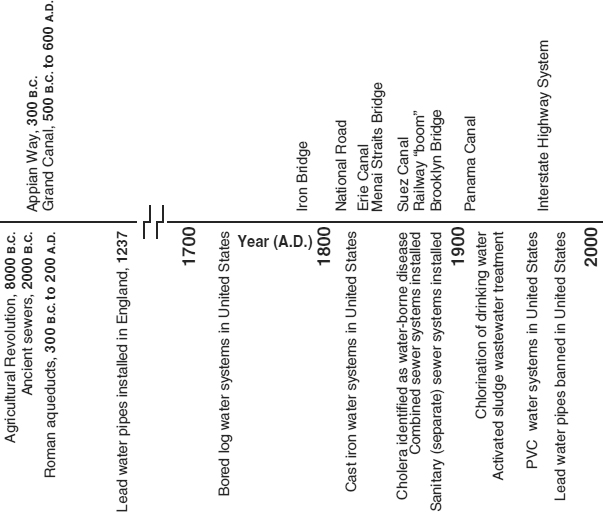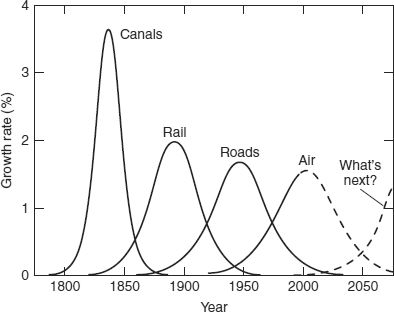Chapter Eight
History, Heritage, and Future
- Introduction
- Introductory Case Study: The National Road
- Themes
- Transportation
- Water Distribution and Treatment
- Wastewater Conveyance and Treatment
- And Then There Was More…
- The Future
- Outro
Learning Objectives
After reading this chapter, you should be able to:
- List the landmark events in the historical evolution of roads, canals, bridges, water distribution, water treatment, wastewater conveyance, and wastewater treatment.
- Explain how technology has been integral in the historic development of infrastructure.
- State examples of lessons that modern engineers can learn by studying the history of infrastructure.
Introduction
In prehistoric times, there was no need for an infrastructure, and no ability to build one. There was no need to transport goods because there were no goods to transport. Before agriculture, there was no need to build irrigation systems. Without permanent residences, there was no need to try to control floods by building levees and dams.
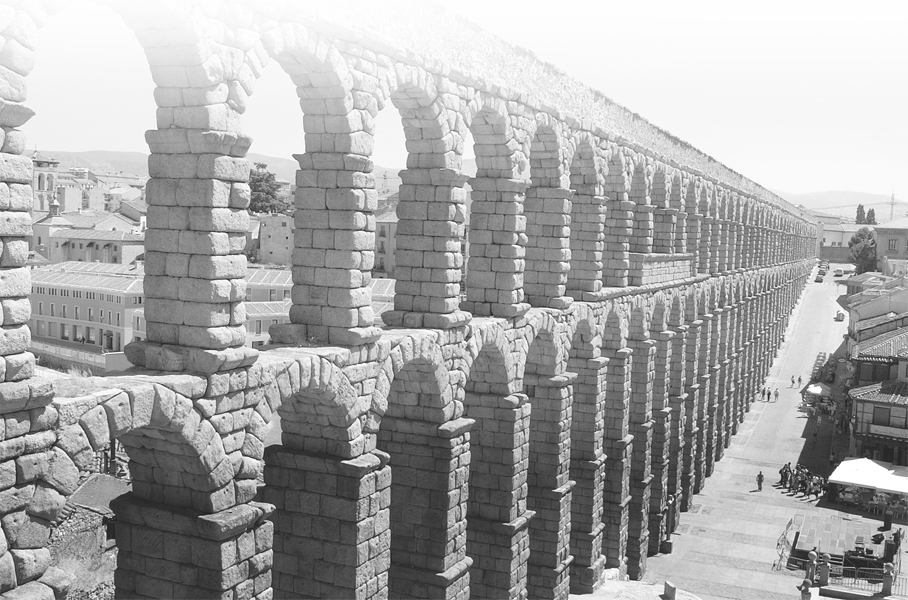
This all changed about 10,000 years ago with the Neolithic (agricultural) Revolution. People transitioned from hunting and gathering to raising crops and forming settlements. As these ancient people started living together in settlements, the need for infrastructure became apparent. For example, there was a need for defense, such as a wall or fence surrounding the settlement. As more crops needed to be grown, irrigation projects were undertaken. As settlements continued to grow to become towns and then cities, people needed a way to deliver increasing quantities of drinking water to the urban center; the nearby springs or streams that had been used for drinking water and cleaning purposes no longer supplied enough water to support the larger and more dense population. Also, removing refuse became necessary in order to reduce odors and the number of insects. Some ancient cities became so advanced that rather than dumping human fecal material in a pit or on the roadside to be washed away by the next rain storm, infrastructure was developed to convey this waste away. Roads were built to move troops, trade goods, and collect taxes.
Reinventing the Wheel
The history of the wheel is somewhat obscure, but it most likely was “reinvented.” The wheel was used in Europe thousands of years before it was used in Mesopotamia, with no apparent link between the two. A similar story can be told of many of the early infrastructure components, including roads, water conveyance, dams, etc. Significant technological advances were accomplished by a few talented people in one part of the world, but due to the lack of communication and travel, the same advances would have to be invented completely separately in other parts of the worlds, perhaps centuries later.

This chapter is intended to be a very brief introduction to the history and heritage of infrastructure development throughout the world. In no way is it meant to be a comprehensive review. Books could be (and have been) written on the history of any one of the infrastructure sectors or components, such as bridges or water conveyance. Even the history of various components associated with water conveyance (e.g., pumps, hydrants, pipes, aqueducts) could be told in volumes rather than in paragraphs or pages. We hope that the few examples we have selected and our brief overview will illustrate the need for infrastructure and help you to better understand why infrastructure is so important to society.
Suggested Reading
The following publications are recommended for additional reading on the history of civil and environmental engineering:
E. Trantowski et al. A History of Public Works in Metropolitan Chicago. 2008. Kansas City, MO: American Public Works Association, 2008.
Civil Engineering Magazine (Special issue: Celebrating the Greatest Profession). 2002, Volume 72, Number 11. American Society of Civil Engineers.
L. H. Berlow. The Reference Guide to Famous Engineering Landmarks of the World. Westport, CT: Greenwood, 1997.
D. L. Schodek. Landmarks in American Civil Engineering. Boston, MA: MIT Press, 1987.
H. Petroski. Remaking the World: Adventures in Engineering. New York: Vintage, 1998.
The Builders. Washington, DC: National Geographic Society, 1998.
Introductory Case Study: The National Road
Also known as the Cumberland Road, the National Road demonstrates the tremendous foresight of early American elected officials. One reason for the road (and a reason that President Washington was a great proponent of another means of transport, namely canals) was to unify the country; that is, to connect the various states and help them work together as a nation.
It was intended that the National Road travel 1,000 miles from Cumberland, Maryland (which was already connected by road to Baltimore) to St. Louis, Missouri. Without such a road, the alternative was to use rivers (which often were impassable during the winter and during dry seasons) and rutted and winding trails. Construction began in 1811 and finished in 1839, although the road never did extend to St. Louis as originally envisioned. The road's path as of 1839 is shown in Figure 8.1. Much of current U.S. Route 40 uses the original alignment, and Interstate 70 in turn follows U.S. Route 40 closely.
Figure 8.1 The National Road.

Specifications for the road included a 66-foot right-of-way with a 20-foot wide travel lane. Drainage ditches were designed for both sides with a maximum road grade of 8.75 percent. The route was set based on ease of construction (parts of it followed a 12-foot wide path that British General William Braddock had cleared in 1755) as well as politics; the route for the first portion was chosen to travel through three states (Virginia, Maryland, and a corner of Pennsylvania, the latter meant to obtain support from that state for the road's construction). Advances were made in construction techniques, and several notable bridges were built (e.g., see Figure 8.2). The road to Ohio was completed in 1818 at a cost of $13,000 per mile (approximately $200,000 per mile when adjusted for inflation).
Figure 8.2 Blaine Hill Bridge (Foreground) on the National Road, was Built in 1828 and Rehabilitated in 2005. An arch bridge carrying Interstate 70 is in the background.
Source: Courtesy of B. Powell.
The completion of the National Road had a tremendous influence on the early American nation. Despite some terrible road surface conditions and varying quality, the cost of transporting goods from Baltimore to Ohio was halved, as was the travel time; 6 weeks before completion, 3 weeks after completion (compared to 6 hours travel time on today's interstates). Manufactured goods from the east could travel to the west, whereas flour, whiskey, bacon and other goods from the west could travel east. However, with rails and canals being increasingly built, the need for roadways was not seen as of great importance, as the former were faster, smoother, and more cost effective.
Unethical Construction Practices
The cost of the National Road, on a per mile basis, ended up being twice as much as originally estimated. There are many reasons for this increased cost, including unethical behavior. Sixteen years after the completion of the first portion of the National Road, the U.S. Army repaired the road and reported eight different ways that local contractors had defrauded the government (by altering the grade, not breaking the stone to the size specified, etc.).
This investment by the U.S. federal government in transportation infrastructure is one of a very few such investments in the 1800s. Strict constructionists of the Constitution felt that due to the concept of states' sovereignty, the federal government should have no role in such activities, and therefore assistance was not provided in building the Erie Canal or further expanding the National Road.
Themes
In the remainder of this chapter, we will trace the history and evolution of a few selected infrastructure sectors. As you read about the history of the sectors, you will note that various themes emerge:
Top Ten Public Works Projects of the 20th Century
The American Public Works Association designated the following projects as outstanding public works projects of the 20th century: Bay Area Rapid Transit District, Grand Coulee Dam & Columbia River Basin Project, Tennessee Valley Project, Panama Canal, Interstate Highway System, Reversal of the Chicago River, Hoover Dam, St. Lawrence Seaway, Hyperion Treatment Plant, and the Golden Gate Bridge. These projects were selected based on the following criteria:
- Significance of the project's effect on the quality of life
- Success in addressing public needs and meeting objectives
- Success in addressing design and construction challenges
- Innovation
- Awareness and protection of the natural and social environment
 Top Ten Public Works Projects
Top Ten Public Works Projects
The human dimension: We realize that many students find reading about history to be boring. We feel that this is so because the focus is often on memorizing facts. Yet history should be viewed as a set of stories about real people, in our case, the people that made infrastructure history happen, but also the people that were affected by the evolving infrastructure.
Technological innovations: The improvement to infrastructure has been an evolutionary process. Many of the improvements took place gradually as new technology was invented. In many instances, that new technology was not created with infrastructure improvement in mind, but was adapted by innovative and thoughtful engineers. In some instances the technology developed “in the field” as the projects were being constructed.
Government responsibility: The monetary investment needed to build and maintain the civil infrastructure is tremendously large, so large that infrastructure is typically funded by governments (the public sector) rather than by individuals or corporations (the private sector). In contrast, the rail, power, and communication infrastructure is largely privately owned and operated. Moreover, when a government is ruling effectively, it can fund and, equally importantly, maintain the infrastructure in order to benefit its citizens. When governments fail or cannot otherwise rule effectively, the infrastructure (and society) often suffers, as is experienced in many developing countries.
Longevity is possible: Infrastructure components exist today that were built hundreds of years, or in extreme cases, millennia ago. They remain because of their functionality, the heritage they represent, and in many instances, their beauty. In many cases, they remain because they were excessively over-designed to ensure safety; when constructed, engineering knowledge did not exist to design and build the components to exacting specifications.
Transportation
ROADS
The earliest transportation mode by humans was on foot, using worn-down paths often originating as wildlife paths. Consequently, the only things transported were the people themselves and whatever they could carry or drag. However, as goods needed to be distributed, as soldiers and their equipment needed to be moved, and as taxes needed to be collected, roads were needed. In many cases, roads were not “engineered” or built to meet this need, but rather paths were gradually widened as animals (e.g., donkeys, oxen) replaced humans for burden bearing. Such roads have been around for more than several thousand years, and indeed were found throughout the United States into the early 19th century and are still found throughout lesser-developed areas of the world.
However, roadways are often not truly useful for moving large amounts of materials until they are properly engineered. Simply packing down the native soil is not effective for many reasons. First, native soil throughout the world is rarely strong enough to support the repeated and frequent loadings associated with a wagon's wheels, a horse's hooves, etc. Moreover, water will not drain properly from a non-engineered road or path, and with frequent use and rainfall, will become rutted, muddy, inefficient, unsafe, and ultimately, unusable. Consequently, goods cannot be moved as rapidly and their price increases, or armies cannot pillage the surrounding countryside as effectively.
The Romans are history's most vaunted road builders, and their roadways were engineered. Many of these roads are still in existence and in use (e.g., Figure 8.3). Nearly 2,000 years ago, the Roman empire constructed 50,000 miles of paved roads (for comparison, the U.S. Interstate Highway System is 42,500 miles) and their entire road network was approximately 250,000 miles long. The most important roads, termed viae (“viae” is the plural of “via”), ranged between 14 and 20 feet wide, which permitted the passage of two carriages. The Roman road systems were built to enhance commerce and to unify their vast empire, but its primary purpose was for moving troops. Armies could move nearly 20 to 30 miles per day on paved roads as compared to 8 miles per day on unpaved roads (in dry weather), and virtually zero miles on unpaved roads (in wet weather).
The first Roman roads were built with the idea of strength. These were extremely time-consuming, expensive, and labor-intensive to build. They had similarities to modern roadways, in that a series of layers were incorporated into the roadway structure (Figure 8.4). From the bottom to the top, the layers consisted of well-compacted dry earth, crushed rock on mortar, concrete, and aggregate. This top layer was often crowned (as seen in Figure 8.4) to shed rainwater.
Figure 8.3 Remains of a Portion of the Appian Way.
Source: Copyright © Paolo Cipriani/iStockphoto.
Figure 8.4 Cross-Section of a Roman Via. A Roman via consists of: (1) compacted earth, (2) gravel aggregate, (3) aggregate of lime, gravel, broken tile or ironwork slag, (4) polygonal stone slabs (shown right) or gravel (shown left), and (5) curbstones.
Source: Redrawn from Sandström, 1970.
The Appian Way (or Via Appia) is seen in Figure 8.3 and was one of the most important Roman roads, the main portion of which was completed in 312 B.C.

It was very successful in meeting its prime objective, which was to move troops. Thanks to disrepair over the millennia, much of it is no longer usable while some portions are no longer in existence. This is a theme we wish to stress in this book, namely the need for maintenance of infrastructure. We hope that by now you realize that engineers don't just design and build things, but they are also involved in managing infrastructure through appropriate maintenance plans.
You may find it surprising that not much happened for the next two millennia as far as advances in road building. But without a stable and unified government, construction of and innovation in major infrastructure projects and innovations are not possible. Perhaps the next important advance in road building occurred in the early 1800s, which was the creation of “Macadam” or macadamized roads, named after their designer, John McAdam. Macadamized roads were much less expensive than other types of road building and were also much longer lasting. Like earlier roads, they were constructed of several layers, but McAdam realized that if the soil underneath the road was well-drained, it would be stronger, and thus the pavement structure itself would not need to provide as much strength. His roads included ditches on both sides to aid in drainage, and, as compared to his contemporary road builders, the bottom layer was composed of cobbles rather than of manually placed stones. Construction is depicted in the painting in Figure 8.5. The top layer was composed of small, angular stones that, as they were compacted by wheels and hooves, packed together and became interlocked, thereby creating a surface that was largely impervious to water. This method was soon widely used throughout the world and was the method chosen for the National Road.
The Interstate Highway System
Officially titled the Dwight D. Eisenhower National System of Interstate and Defense Highways, the Interstate Highway system is considered one of the greatest public works projects in history. Originally designated by the Federal-Aid Highway Act of 1944, it was not destined to become a reality until the Federal-Aid Highway Act of 1956 (which included the declaration that such a system was “essential to the national interest” of private, commercial, and military ground transport). President Eisenhower strongly promoted the system that he correctly envisioned would “change the face of America.” Expansion of the originally planned 40,000 miles of expressways continues to this day.
Macadam roads and gravel roads suited the horses that were the primary mode of providing motive power. The surfaces provided some “give” that were easier on hooves. However, the advent of self-propelled vehicles riding on rubber wheels at relatively high speeds had two effects on these early roads: rubber wheels did not get adequate traction and at high speeds vehicles “sucked” dust out of the road, leading to degradation of the pavement. In response, tar was used to grout the macadam, leading to the term tarmacadam (or “tarmac”). Ultimately road construction evolved to today's “sealed” asphalt and concrete pavement structures.
Figure 8.5 Laying of the First Macadam Road. Workers in the foreground are seen breaking rocks for the base. Rocks needed to be small enough “so as not to exceed 6 ounces in weight or to pass a two-inch ring.”
Source: Painting by Carl Rakeman.
CANALS
Although canals are currently not a prime means of moving goods in most of the developed world, for much of history, moving goods by water was the most economical means to do so. Canals came into prominence in the late 1700s and early 1800s, spurred on by the Industrial Revolution's need for resources and ability to move products to market. However, they have been used for millennia, with China's Grand Canal being the oldest (large portions constructed in the 5th century b.c.) and longest canal (over 1,000 miles in length).

Constructing canals was a challenging venture, as they needed to cross rivers and mountains, all while maintaining a relatively consistent slope (1 to 2 inches in elevation change per mile). A significant amount of earth needed to be moved, and in many cases, locks were needed. You might wonder how these early engineers learned these skills. In many cases, they had no formal education; indeed, there was no such thing as civil engineering discipline. Many of the early canal engineers were surveyors that learned on the job, in many instances from their own mistakes.
Perhaps no infrastructure project had a greater impact on America than the Erie Canal, which opened in 1825. By connecting the Hudson River to Lake Erie (Figure 8.6), it provided a route for commerce between the midwestern United States and the Atlantic Ocean, and therefore the entire world. Indeed, some have said that the Erie Canal started “globalization.”
 Images of the Erie Canal
Images of the Erie Canal
Figure 8.6 Map of the Erie Canal.

Figure 8.7 Aqueduct on the Erie Canal. Canal boats would travel across the river, which can be seen below the aqueduct, while being pulled by mules that walked on the adjacent towpath (now a recreational trail) in the foreground.
Source: Courtesy of G. Frysinger.
The canal width was 40 feet and boats could carry 30 tons of freight. Although this is relatively small compared to ships that traverse the Panama Canal today (cargo capacity greater than 50,000 tons), it was substantially more than roads at the time could bear. Boats were pulled along by mules or horses that walked on towpaths (see Figure 8.7).
Like any canal, the Erie Canal required a large capital investment, and its construction in the United States was initially hindered as the federal government was reluctant to finance the canal and private investors could not raise enough capital. Eventually, the canal was constructed primarily by public money from New York state. To accomplish this funding, strong political leadership was required, which was supplied by New York Governor DeWitt Clinton. Like many visionaries, Governor Clinton was scoffed at, and his detractors famously referred to the proposed canal as “Clinton's Ditch.”
The Erie Canal was very successful by nearly every measure and affected the nation in lasting ways. The costs of transportation (of products and migrating pioneers from east to west and natural resources from west to east), which before relied on a combination of boats and horse-drawn wagons, were cut 95 percent. The canal was also responsible for making New York City the primary port in the United States. Moreover, it changed the face of the nation as it opened up the western frontier in ways that the National Road never did.
Although canals had a tremendous positive impact for a few decades, railroads made them obsolete by the mid-1800s. Currently, many inland canals such as the Erie Canal are used primarily for recreation and tourism. China's Grand Canal is still used, and of course, the Panama Canal and Suez Canal remain integral components of the modern economy.
Case in Point: Suez and Panama Canals
The Suez Canal (completed in 1869) and the Panama Canal (completed in 1914) are historic canals that have had tremendous impacts on the global economy. About 18,000 ships a year move through the Suez Canal and more than 14,000 through the Panama. Their construction saved thousands of miles for shipping and made the trips (e.g., from New York City to India, Italy, or the west coast of the United States) much safer or cost-effective than alternative routes, which were either around the southern tips of South America or Africa, or across land. As a result, the cost of transporting goods was greatly reduced.

Construction of these canals was a tremendous undertaking. Although the Suez Canal is about twice as long as the Panama Canal, the latter was much more difficult to construct. Unlike the Panama Canal, the Suez Canal does not have any locks—it is simply a single-level waterway connecting the Red Sea to the Mediterranean Sea. Also, construction workers of the Panama Canal had many tropical diseases to contend with such as malaria and yellow fever. Without the discovery that mosquitoes were the carriers of these diseases and the resulting protective measures, it is unlikely that the canal would have been completed. Indeed, construction of the Panama Canal had been abandoned by the French in the 1890s due to more than 20,000 worker deaths.
Construction of both canals had unsavory aspects. For example, the Suez Canal was built with many slaves, with much of the digging by hand (some of the digging was literally “by hand,” as the slaves were not equipped with shovels). Panama was originally governed by Columbia. When Columbia refused to allow the United States to build across Panama, the United States supported a Panamanian revolution, and when the new country declared independence, U.S. troops blocked Columbian ships from Panama. Perhaps not surprisingly, the new country of Panama accepted the treaty with the U.S. allowing the U.S. to build the canal.
BRIDGES
The story of the history of bridges is in one sense the story of the introduction of new technology, especially of new materials. Through the ages, bridges have been built primarily of two materials: timber or stone. These materials have been used to create many beautiful and functional bridges, some of which have stood for thousands of years. Indeed, few materials are as beautiful or as able to withstand the elements of nature as stone. However, newer materials are much less costly and easier to handle and to build with, and allow for taller, longer, stronger bridges that can cross gaps that previously were not economically, and sometimes, not technically feasible.
Iron was used as a bridge material beginning in the late 1700s, first in the picturesque (and aptly named) Iron Bridge (Figure 8.8), located in England. Previously, iron had been too expensive to use for building a structure as large as a bridge, but became cost-effective thanks to technological advances in iron making. The first iron bridge built in the United States was built on the National Road.

The use of iron in bridges continued and was adapted to suspension bridges. Suspension bridges offered the ability to traverse wide spans without needing central piers. This improved constructability and river navigability, and provided new opportunities to build beauty into bridges. The most notable early suspension bridge is Thomas Telford's Menai Straits Bridge, located in North Wales. Approaching 200 years old, the bridge still carries traffic.
With increasing technological progress in the making of iron, continued advances to bridge design occurred, notably the Britannia Bridge (Figure 8.9), which also crossed the Menai Straits. As with so many early engineering accomplishments, engineers did not have textbooks to rely upon, or even much in the way of a theoretical understanding. The Britannia Bridge was notable in that, although it did not rely on theoretical structural engineering, it at least relied on testing of different material shapes prior to being constructed. The unique rectangular shape (see Figure 8.9) was found to be most efficient, and it is through the middle of this iron “tube” that rail traffic moved. Although five times as expensive as the nearby Menai Straights Bridge, the Britannia Bridge was much more rigid.
Engineers soon came to realize that the rectangular box section of the Britannia Bridge wasted a significant amount of iron, and therefore was unnecessarily costly. The truss was developed in the late 1800s and was used widely in bridges for the next 100 years. A truss is a lattice that consists of many triangular shapes. As such, imagine cutting triangular shapes of iron out of the Britannia box section; in essence, the remaining iron is a truss. Most railroad bridges were composed of trusses as they offered exceptional rigidity and strength at a relatively low cost. Combined with the development of steel, a number of innovations were possible, as seen in one of the earliest and most remarkable bridges that utilized trusses, the Firth of Forth bridge (Figure 8.10); it is named for the estuary, or “firth,” it crosses where the River Forth flows into the North Sea. In time, the box cross-sections of the Britannia Bridge were replaced with steel truss arches.
Figure 8.8 The Iron Bridge.
Source: Copyright © John Hallett/iStockphoto.
Figure 8.9 Britannia Bridge.
Source: Williams, F.S. (1852).
The use of materials continued to evolve, and today, one of the most common materials for bridge construction is concrete. Concrete is notable because it is very strong in compression, but relatively weak in tension. This means that when you “push” on concrete, or place it under compression, it can withstand tremendous forces; however, when you “pull” on concrete (place it under tension), it can easily fail. Structural members of bridges are subject to both compression and tension. Thus, the use of concrete in large bridges was minimal until the widespread development of reinforced concrete, which is reinforced with steel. Steel is very strong in tension, and thus when properly placed within the concrete structure, can carry the tensile forces that concrete cannot.
Figure 8.10 Firth of Forth Railway Bridge.
Source: Copyright © Bridget McGill/iStockphoto.

The development of bridges also led to many new construction techniques to address unique challenges. For example, the tubes for the Britannia Bridge weighed 3 million pounds, and needed to be lifted into place, over water. The famous Brooklyn Bridge needed to have 3,600 miles of wire (which was bundled together into cables) strung across it. Caissons and cofferdams had to be built to allow the construction of piers to occur safely in and under water.
 Video of Construction of the Brooklyn Bridge
Video of Construction of the Brooklyn Bridge
Consequences of Failure
If, in your future engineering career, a project you design or construct fails, the consequences may be grave. Depending on the extent of the failure and the extent (if any) of your negligence, the consequences to you may be a reprimand, loss of your job, or loss of your professional engineer (PE) license (plus the personal anguish of the responsibility for any victims of the failure).
But consider the engineers involved in moving Xerxes' troops (Xerxes was the king of Persia in the fifth century B.C.) across the Dardanelles into Greece. When their attempts to do so by anchoring and tying 614 ships together failed, they were beheaded. The picturesque Stari Most, or “Old Bridge,” (Figure 8.11) in Bosnia/Herzegovina has a similar story. Constructed in the 1560s, legend has it that the bridge collapsed when the falsework was removed from the bridge. (Falsework is the temporary structure used to help builders construct the bridge). The engineer was then ordered to build it again, with the threat of beheading if the bridge failed. One story has it that the engineer fled before the falsework was removed the second time, while another story has it that the engineer prepared for his own funeral “just in case.” In any event, the bridge stood until 1993 when it was destroyed by mortar fire during the Bosnian War.
Figure 8.11 Stari Most.
Source: Copyright © Tanja Suli![]() /iStockphoto.
/iStockphoto.

Water Distribution and Treatment
WATER DISTRIBUTION
The earliest form of water conveyance was in containers on the backs and heads of people. As civilizations became more advanced and as water had to be carried greater distances, conveyance systems using human-made channels and later, pipelines, were constructed.
Qanats have been used for millennia throughout Asia and North Africa to convey water, and are still widely used today. Qanats are human-made underground tunnels that intersect the groundwater table and convey the water to the surface some distance away. They function as shown in Figure 8.12. You can imagine how dangerous digging these wells and the connecting tunnels must have been; indeed, some workers wore their funeral clothes while digging in case they were buried alive.
Figure 8.12 Cross-section of a qanat.
In addition to being outstanding road- and bridge-builders, the Romans were highly capable at water distribution. They built an infrastructure that allowed fresh water to be brought into Rome via aqueducts (Figure 8.13), and built aqueducts throughout their empire.
Figure 8.13 Example of a Roman Aqueduct, Built in Segovia, Spain.
Source: Copyright © Alan Crawford/iStockphoto.
The water that flowed into ancient Rome did not do so solely in elevated aqueducts. It was also conveyed in tunnels, streams, pipes, and channels constructed at ground level. But, when a gully or gorge needed to be crossed, or where a long, gentle slope was desired that could not otherwise be obtained by building at ground level, elevated aqueducts were used. Pipes could also be used for such situations, but the technology of constructing pipes able to withstand the high pressures was limited at the time. Lead pipes were used throughout the empire, but the stone aqueducts were technologically and economically more feasible to construct for conveying large amounts of water.
The aqueducts supplying Rome conveyed a tremendous amount of water, estimated at about 50 million gallons per day at their peak, which corresponds to approximately 50 gallons per person (which is much more than the water use in most developing counties today). This water was conveyed to some private residences and public buildings, although most private residents obtained water from public fountains. The large amount of water transmitted was not all actually used by the Romans, however, as much of it simply passed through the city.
Another notable event in the history of water conveyance occurred in 1237, when lead pipes were used to convey water from Tyburn Springs to the City of London. The water was transported nearly 3.5 miles to a central location where city dwellers could obtain the water for free. The ability to expand these early systems was limited by technology—the ability to pump water and to deliver it cost-effectively via pipelines. The first water distribution systems in the United States were built in the mid-1700s. The turn of the 20th century brought about a tremendous increase in the number of cities with public water distribution, and by the early 1900s, nearly all cities in the United States had water distribution of some sort.
As cities became larger, water was seen as essential for firefighting purposes. Indeed, that was the sole purpose of some of the earliest municipal systems. Other uses were for domestic use, and, at the start of the 20th century, to flush human waste from “water closets.”
Early pipes were made of lead or of bored out logs. If larger pipes were needed that could be made from logs, wood stave pipes (a stave is a slat of wood) were used (see Chapter 5, Figure 5.11). Surprisingly, some wooden pipes are still in service today in U.S. cities. During the 1800s, advances in ironworking led to the popularity of wrought iron and cast iron pipes. The later discovery that lead piping created a significant health hazard because of leaching of lead into drinking water resulted in the ban of its use. However, as with wooden pipes, lead pipes are still in service in many communities.
The World's First Engineer
Vitruvius was a Roman writer and architect who lived in the first century B.C. He has been called the world's first engineer. He wrote The Ten Books on Architecture, three of which were devoted to technology. He stated that a structure should have three characteristics (firmitas, utilitas, and venustas or durable, useful, and beautiful), advice that modern engineers should heed. He appears to have designed war machines (e.g., catapults) and wrote much about the aqueducts and the state of the art of surveying.
WATER TREATMENT
Humans have not always treated water prior to drinking, and even today, groundwater and surface water is directly consumed by many people world-wide. Much surface water would be safe to drink if not contaminated by fecal material. As humans began to congregate into larger groups, increased contamination of groundwater and surface water occurred. People polluted the surface water by defecating directly into the surface water or emptying their chamber pots into the surface water. Early wells were quite shallow due to available well-digging methods (i.e., a shovel, a bucket, and a rope), and thus were also easily contaminated; waste that had been dumped into cesspools or cesspits could readily travel underground into these wells.
The result of the mixing of wastewater with drinking water resources resulted in countless deaths due to water-borne diseases. The cause of these much-feared diseases (e.g., cholera and typhoid) are pathogens that originate from human fecal material.
Fecal material is also known as poop.
A cholera epidemic in London in the mid-1800s caused more than 600 deaths. When this epidemic occurred, an estimated three-fourths of the city's residents fled to the countryside. This epidemic is notable not due to the number of fatalities, but rather that for the first time, a link was made between the cholera cases and drinking water. Prior to this, people didn't know if cholera (and other diseases that we now know to be water-borne) was water-borne or air-borne. Dr. John Snow, by plotting cholera deaths on a map, found that they were clustered around a single well. Removing the well handle (and thus access to the water) effectively ended the epidemic. Later, the water source was found to be contaminated from a nearby cesspit.
Thomas Crapper
The toilet transformed the way homes functioned and smelled, and contributed to sanitary conditions. Legend has it that the toilet was invented by Englishman Thomas Crapper; however, despite the fitting name, the toilet was not invented by Mr. Crapper, and the actual inventor is unknown. Flush toilets gained popularity in the late 1800s to early 1900s, but as recent as 1950,25 percent of American homes still used outhouses.
The fact that cholera is water-borne is one of the most important public health discoveries in history. But even at the time of its discovery, Dr. Snow and his contemporaries did not fully understand the cause of the cholera disease. Indeed, he writes in one of his reports on the Broad Street case of the “cholera poison” (implying a chemical nature). It was not until the end of the 19th century that the “germ theory” was discovered by Dr. Louis Pasteur; at this time, people first understood that the cause of cholera was microbiological in nature.
Early treatment of water by municipalities consisted of filtration through sand beds. These were common beginning in the mid- and late 1800s, and are still commonly used today. It was found that filtration effectively removed particles from the water, many of which caused objectionable tastes and odors. Later analyses showed that the filters also removed some (but not all) pathogens. However, it wasn't until the advent of chlorination that many water-borne diseases were virtually eliminated. The relationship between filtration and chlorination on typhoid outbreaks is shown in Figure 8.14.
The dramatic effect of water treatment on human health cannot be under-stated. Now, engineers continue to work at decreasing the possibility of disease transmission by water and there are increasingly strict regulations. Moreover, much work needs to be done worldwide to prevent millions of deaths annually due to water-borne diseases in developing nations.
Figure 8.14 Effect of Water Treatment on Number of Typhoid Cases in the United States.
Source: Courtesy of E. G. Garrison, 1998.
Figure 8.15 Roman Latrine.
Source: Copyright © Pascal RATEAU/iStockphoto.
Wastewater Conveyance and Treatment
WASTEWATER CONVEYANCE
The earliest form of wastewater conveyance, similar to early water conveyance, was by people carrying the waste in containers and dumping them outside their settlement. This activity was not to prevent water-borne diseases that were not understood at the time, but rather to decrease odors and the number of insects. This method continues to be used in many developing countries today.
Wastewater conveyance via pipes and channels can be traced to before 2000 B.C., with systems in ancient Greece, Rome, China, and Egypt. Many of these systems functioned by having a large quantity of water continuously flush through them. In some cities there were connections to elite residences, but otherwise people relieved themselves into chamber pots that they dumped in street openings to the sewer or, in Rome, by using one of the pay latrines (Figure 8.15)

During the 19th century, many cities collected human sanitary waste, but not with pipes. Rather, people would defecate in chamber pots and leave them outside at night. The contents were delicately referred to as night soil. The contents would be collected and dumped in cesspits or in water bodies outside of city boundaries.
Once indoor water closets were available with flush toilets, the toilets needed to be connected to conveyance pipes; the most readily available pipes were the pipes in the storm sewer system. The resulting sewer system is known as a combined system (combining sanitary and stormwater), and were commonly constructed in the early 20th century. Indeed, many U.S. cities still are served by combined sewers. However, all newly constructed storm sewer and wastewater systems must be separated.
WASTEWATER TREATMENT
Civilizations have conveyed their wastewater for many centuries, but it is only until relatively recently that they have considered treating the wastewater. The philosophy seemed to be “out of sight (or out of nose-range), out of mind.”
The first treatment method was to precipitate out the organic content using ferric sulfate. Around 1900, trickling filters were first used—bacteria attached to a substrate (e.g., rocks in the early stages of trickling filter construction and corrugated plastic media today) consume the dissolved organics in the wastewater as the wastewater trickles over the substrate. The activated sludge treatment process, which is very common today, was first introduced in 1916 with the first large-scale facility starting operation in Milwaukee, Wisconsin, in 1925.

Today, much of the world lacks proper sanitation, and significant public health risks are common as discussed in greater detail in Chapter 13, Sustainability Considerations.
Cloacina, Goddess of the Sewers
The Cloaca Maxima was constructed in Rome starting in perhaps 500 B.C. It was the “main drain” for the city and was flushed out by water brought to the city in the aqueducts. The Romans believed that the Goddess Cloacina oversaw the sewer systems. She was honored with a shrine and coins; some have even suggested the following poem might have been offered in prayer to Cloacina!
“O Cloacina, Goddess of this place,
Look on thy suppliants with a smiling face.
Soft, yet cohesive let their offerings flow,
Not rashly swift nor insolently slow.”
And Then There Was More…
The examples presented thus far in this chapter of the history of transportation, water, and wastewater infrastructure illustrate the lessons to be learned from infrastructure development. Other infrastructure sectors and components could also have been highlighted but for space constraints have not been. This is not to say they are not historically important.
For example, much could be (and has been) written about railroads. Like much of the U.S. infrastructure, their burgeoning success in the mid- and late 1800s (from 10,000 miles of railway in 1850 to over 100,000 miles in 1890) was the result of a variety of previously unrelated technologies working together, namely the development of steam engines to pull the heavy loads up the relatively steep grades of the western U.S. railroads and the economical production of steel that was needed for the thousands of miles of rails. Also, like canals, railroads were a key component in increasing the trade capabilities of the nation and helped unify the country. Additionally, the government role in helping promote the railroad was significant, including issuing of government bonds (bonds will be presented in Chapter 14, Economic Considerations) and by giving 10 square miles of land to the railroads for each mile of track constructed.
Ports also are a very important part of the history of infrastructure. Even when the Romans had their exceptional road system in place, water was still the most cost-effective means of transporting goods. The infrastructure for water transport is relatively simple; no connecting infrastructure such as roads or railroad tracks are needed. But a port at each end of the journey is essential.
A summary timeline of several of the important infrastructure accomplishments and events mentioned in this chapter is presented in Figure 8.16.
The Worst Job Ever?
Cesspits had to be cleaned out regularly. This job was relegated to “gong farmers.” According to the Oxford English Dictionary, the word “gong” refers to a privy (outhouse) or its contents. If only television were available at the time, certainly these laborers would have been highlighted in the show “Dirty Jobs.”
The Future
The concept of diffusion of technology (Figure 8.17), also termed adoption of technology, describes the rate at which new technology is adopted by society, and is useful when contemplating the future of infrastructure engineering. The shape of the “bell curve” (solid line) is typical of the adoption rate of personal computers, telephones, microwave ovens, etc. The x-axis represents the time that has passed since the technology was originally invented and adopted. Depending on when you “adopt” the new technology, you may be labeled as an “innovator,” an “early adopter,” or even a “laggard.”
Machu Picchu: A Civil Engineering Marvel
The book, Machu Picchu: A Civil Engineering Marvel written by Kenneth Wright and Alfredo Valencia Zegarra, details the planning and construction of the structures as well as the hydrology and hydraulics of the site.

 Interview with Kenneth Wright
Interview with Kenneth Wright
Figure 8.16 A Timeline of Infrastructure History as Presented in This Chapter.
Importance of Ports
As the city of Rome increased in size in the 1st century, it often underwent food shortages, especially in winter months. This problem was due in part to a lack of infrastructure, specifically a port. When an angry mob showed their displeasure to the Emperor Claudius by pelting him with bread crusts, he responded by building the harbor of Portus.
This theory can also be applied to the adoption of new infrastructure systems. For example, the historical (and projected future) growth in system length for various modes of transportation is presented in Figure 8.18; the diffusion of innovation “bell curve” is seen for each transportation mode.
As you consider the future of infrastructure in light of Figure 8.18, you should be asking yourself, “what comes next?” The peaks in Figure 8.18 arrive at intervals of approximately 60 years. The future of transportation may be maglev, or magnetic levitation, trains, or it may be a technology that is currently in even earlier stages of development. It is easy to scoff at this prediction and to believe that in 50 years we will still be using automobiles as our primary personal transportation mode for example, or to say “we will never use trains regularly in place of automobiles.” But recall that this same outlook in the mid-1800s was one of the reasons that the National Road was not completed: many people felt there was no future in roadways, but rather that canals and railways were the future!
Figure 8.17 The Diffusion of Technology.
Source: The names of the adopter categories are borrowed from Rogers, 2003.
Figure 8.18 The Historical and Projected Future Growth Rates of Various Transportation System Lengths Since 1800.
Source: Redrawn from Grubler, 1990.
The Importance of Information Technology
Tremendous advances in data collection and data processing have been made, and will continue to be made. There is a new focus on “smart grids,” “smart roads,” etc. Sensors are being developed to very accurately measure environmental pollution, precipitation events, stresses on structural members, and traffic patterns at remote locations with real-time feedback. This information allows engineers and scientists to not only evaluate the functionality of existing or prototype infrastructure systems, it also contributes to an ever-increasing data set that aids future research and development.
Figure 8.18 can also be instructive when combined with the labels of Figure 8.17 and by considering your future in infrastructure development. Just as we can think of different people adopting technologies at various rates, we can also consider the people who have invented and marketed the new technologies. Will you be an “innovator” in the new transportation technology that may begin to appear in the very near future? Such a role is a “riskier” role, and by its very nature, will most likely be a role not desired by many people. Or, perhaps you will wait, working in areas that have reached “saturation.” In such areas, you will still have opportunity for some innovation, but the work will most likely be involved in maintenance and rehabilitation rather than in new construction.
Figure 8.18 can also be applied to any sector of infrastructure and at many different levels, from the sector level to the subsector level to the component level. For example, a similar graph could be drawn for various types of dams that have been constructed through the ages, different types of wastewater treatment processes, different types of pumps, etc.
The future holds many exciting projects awaiting infrastructure engineers. A very large pumping station, the West Closure Complex Pump Station, is currently being designed for New Orleans; $5 billion is being spent to expand the Panama Canal; high-speed rail is being planned throughout the United States. In your lifetime the tallest building will be completed, as will the longest pipeline, the fastest train, and the most resilient bridge.
 Video on Future Bridges
Video on Future Bridges
The National Academy of Engineering recently identified several “Grand Challenges” for the upcoming century. Those challenges, as well as the great challenges that were met in the past century are listed in Table 8.1. Note how many of these challenges directly relate to the infrastructure, and how many of them are indirectly dependent upon effective infrastructure.
 Grand Challenges
Grand Challenges
Outro
By reading this brief introduction to the history of infrastructure, we hope that you more fully understand the importance of infrastructure and how it is necessary for the functioning of society. By revisiting our four themes in historical contexts, we hope you better appreciate the human dimension of infrastructure, the need for engineers who are innovative and eager to adopt new technologies, the need for a strong government and visionary leaders. Moreover, we hope you consider longevity and aesthetics in your future engineering projects.
Note that these themes will be revisited in other chapters. The human dimension will be explored in more detail in Chapter 16, Social Considerations. New technologies will be covered in many chapters, including the Design and Analysis chapters (Chapters 9, 10, 20, and 21). Chapter 19, Other Considerations, will discuss the politics involved in infrastructure construction and management, and also aesthetics.
Table 8.1 The Grand Challenges and Achievements of Engineering
| Challenges for the Next Century | Achievements of the Past Century |
| Make solar energy economical | Electrification |
| Provide energy from fusion | Automobile |
| Develop carbon sequestration methods | Airplane |
| Manage the nitrogen cycle | Water supply and distribution |
| Provide access to clean water | Electronics |
| Restore and improve urban infrastructure | Radio and television |
| Advance health informatics | Agricultural mechanization |
| Engineer better medicines | Computers |
| Reverse-engineer the brain | Telephone |
| Prevent nuclear terror | Air-conditioning and refrigeration |
| Secure cyberspace | Highways |
| Enhance virtual reality | Spacecraft |
| Advance personalized learning | Internet |
| Engineer the tools of scientific discovery | Imaging Household appliances Health technologies Petroleum and petrochemical technologies Laser and fiber optics Nuclear technologies High performance materials |
Source: National Academy of Engineering.
chapter Eight Homework Problems
- 8.1 Why was construction of the National Road so important to the young American nation?
- 8.2 How did John McAdam's roads differ from the Roman roads?
- 8.3 How did the federal government help finance the construction of the transcontinental railroad?
- 8.4 What new technologies were important in the history of bridges?
- 8.5 What is the “germ theory” and how is it important to the history of water treatment?
- 8.6 Why did the Romans use elevated aqueducts instead of pipes to convey their water?
- 8.7 What are combined sewers?
- 8.8 One reason that some infrastructure is preserved by society is that society finds it beautiful. Predict the infrastructure on your campus that will be preserved for 100 more years, in part because of its beauty.
- 8.9 Which of the Grand Challenges for the 21st century do you believe is most important? Why? Which challenge do you believe to be the least important? Why? What challenge do you believe should be added to the list? Why?
- 8.10 New infrastructure may be needed in the near future to allow the “refueling” of electric vehicles. Should the public sector provide this infrastructure, or should the private sector? Explain your reasoning.
8.11 For one of the following historic infrastructure projects, (1) describe the project and explain why it was needed; (2) If possible, state how much it cost, in today's dollars using an Internet “inflation calculator”; (3) list its beneficial and negative effects; (4) explain the role of new technology; (5) list the ways it affected people; (6) describe the role of government (federal, state, local) in the project.
- St. Lawrence Seaway
- China's Grand Canal
- Paris historic sewer system
- New York City's historic water treatment and distribution system
- Brooklyn Bridge
- Cloaca Maxima
- Eads Bridge
- Severn Tunnel
- Grand Coulee Dam
- Hoover Dam
- Machu Picchu irrigation system
- Rideau Canal
- Lincoln Tunnel
- London Bridge
- Transcontinental Railroad
- Trans-Siberian Railway
- Trans-Alaska pipeline
- “Chunnel”
- Empire State Building
8.12 List the milestone events in the history of the evolution of one of the following infrastructure components.
- Airports
- Ports
- Locks
- Tunnels
- Bicycle transit
- Skyscrapers
- Dams
- Hazardous waste management
- Landfills
- Railroads
- 8.13 For one of the components in Homework Problem 8.12, describe the role of technology in the component's history.
8.14 Select one of the following famous infrastructure engineers. Address (1) main contributions; (2) educational experiences; (3) obstacles faced; (4) risks taken; (5) information they added to the knowledge base.
- Thomas Telford
- Benjamin Wright
- Isambard Kingdom Brunel
- Karl Terzaghi
- Gustave Eiffel
- Ellis Chesbrough
- Robert Fulton
- Theodore Judah
- John Roebling
- Emily Roebling
- Squire Whipple
- Abel Wolman
- James Eads
- Ellen Swallow Richards
- John Smeaton
- Elsie Eaves
Key Terms
- diffusion of technology
- fecalmaterial
- government responsibility
- grand challenges
- human dimension
- longevity
- private sector
- public sector
- reinforced concrete
- technological innovation
References
American Public Works Association. Top Ten Public Works Projects of the Century. http://www.apwa.net/Resources/Reporter/Articles/2000/11/Top-Ten-Public-Works-Projects-of-the-Century, accessed August 8, 2011.
Garrison, E. G. A History of Engineering and Technology: Artful Methods. CRC Press, 1998.
Grubler, A. The Rise and Fall of Infrastructures: Dynamics of Evolution and Technological Change in Transport (Contributions to Economics). New York: Springer-Verlag, 1990.
National Academy of Engineering. Grand Challenges for Engineering. http://www.engineeringchallenges.org/cms/8996/9221.aspx, accessed August 8, 2011.
National Academy of Engineering. Greatest Engineering Achievements of the 20th Century. http://www.greatachievements.org/, accessed August 8, 2011.
Rogers, E.M. Diffusion of Innovations. New York: Free Press, 2003.
Sandström, G.E. Man the Builder. New York: McGraw-Hill, 1970.
Williams, F.S. Our Iron Roads: Their History, Construction, and Social Influences. New York: Ingram, Cooke, and Co, 1852.
Wright, K.R. and A.V. Zegarro. Machu Picchu: A Civil Engineering Marvel. Reston, VA: American Society of Civil Engineers, 2000.

